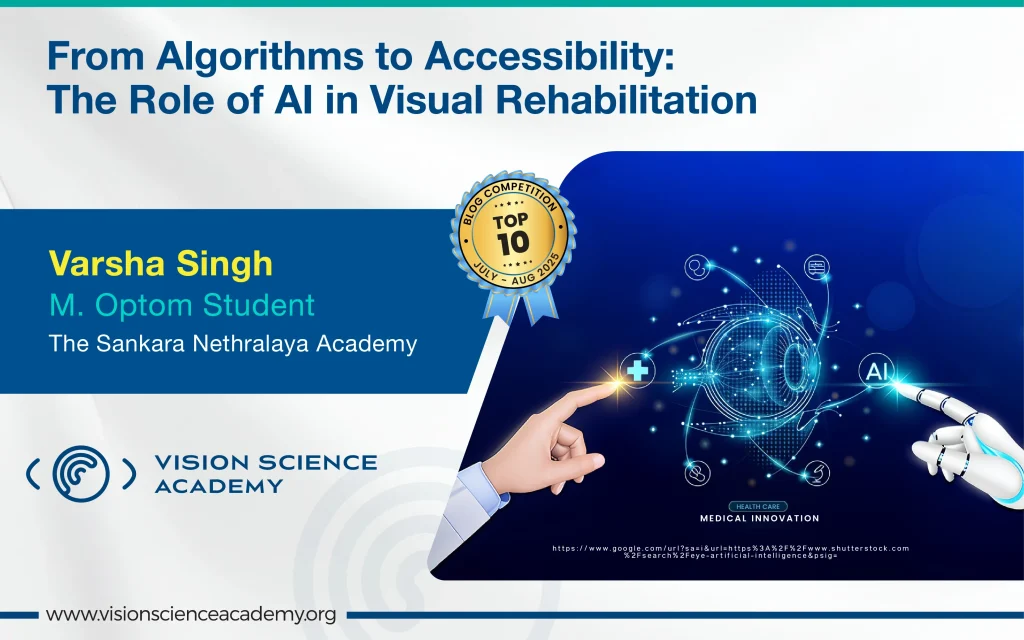Varsha Singh, B. Optom.
M. Optom Student, The Sankara Nethralaya Academy, Chennai, India
According to recent World Health Organisation (WHO) data, around 2.2 billion people globally have near or distance vision impairment, with the reported leading causes of vision impairment and blindness being cataract and uncorrected refractive errors. (1) Vision impairment affects the lives of individuals in many ways, whether socially, personally, or economically, and it also poses a huge financial burden, with an approximate global productivity loss of about US$411 billion yearly. (2) According to the global data, around 70 million people require rehabilitation services, but only 5–10% of that population can access them. (3) Rehabilitation plays a very crucial role in these individuals by providing them with the confidence to integrate into society and live life independently and confidently, by getting assistance from the emerging AI technologies rather than depending on others. (4)
Figure 1: Global Access to Visual Rehabilitation Services
How AI is Transforming Accessibility for the Visually Impaired
AI-Based Mobility Solutions
Mobility is one of the major difficulties faced by visually impaired persons, and with the new AI-based solutions, we can address the challenges this population is facing in the form of navigation tools such as apps like Seeing AI and Aira that help individuals detect obstacles in their path through verbal information, providing them with step-by-step instructions to guide them throughout the path. (5)
Smart Wearables
Facial recognition is a very crucial aspect; it makes you inclusive in society as you can appreciate facial expressions. It helps in building relationships and understanding the emotions of the person. The examples of such tools that provide face recognition feature are I i-Recognise U (Raspberry Pi + Camera), Smartwatch FR System (Samsung Gear smartwatch), and GL Access (Smart Glasses + Server). (6)
Smart Assistants and Voice-Controlled Devices
These are AI-powered technologies that understand your verbal commands and accordingly assist you in performing non-physical tasks, like reading text for you or assisting you with your mobile phone. The first one popularised and used globally is Apple Inc.’s Siri. The more advanced one, for example, Amazon Inc.’s Alexa, can control the electronic devices in the room, so you just need to command whether you want to play music, switch on lights, fan, AC, etc., which will ease daily living for individuals with visual impairment. (7)
Tactile Graphics Generation
Tactile graphics basically mean the raised lines that help visually impaired persons use their sense of touch to recognise content, which can be anything like maps, diagrams, charts, educational content, etc., and are considered an important tool for completely visually impaired individuals who are around 43 million globally, to access education. There is a tool called TactileNet, which is used to generate tactile templates and has reported a compliance of 92.86% when assessed by experts, and it can generate 32,000 images across 66 categories with 7,050 high-quality ones that are highly customizable and support experts in making tactile graphics faster and the production can be done on a large scale. (8)
Figure 2: Flow of Working of TactileNet
| AI Technology | Key Functionality | Examples |
|---|---|---|
| Mobility Solutions | Detect obstacles, verbal guidance for safe navigation | Seeing AI, Aira |
| Smart Wearables | Facial recognition, emotion detection for social inclusion | I Recognise U, Samsung Gear, GL Access |
| Voice-Controlled Assistants | Read text, control home devices via verbal commands | Apple Siri, Amazon Alexa |
| Tactile Graphics Generation | Raised lines to represent maps, diagrams, and charts for education | TactileNet (32,000 customizable images) |
Table 1: Summary of AI Technologies for Accessibility
Conclusion
As technology continues to grow, we are finding smarter solutions for almost everything. What is exciting is how AI is now being used in rehabilitation; it is helping people feel more empowered by offering practical tools that make their daily lives easier, promote inclusivity in society, and improve accessibility. (9)
References
- GBD 2019 Blindness and Vision Impairment Collaborators, & Vision Loss Expert Group of the Global Burden of Disease Study (2021). The Lancet Global Health, 9(2), e144–e160.
- Burton, M. J. et al. (2021). The Lancet Global Health Commission on Global Eye Health, 9(4), e489–e551.
- Chiang, P. P. C. (2009). The Global Mapping of Low Vision Services. University of Melbourne.
- Cai, C., Shuai, Y., & Li, G. (2025). BMC Ophthalmology, 25(1), 20.
- Arabic, B. G. et al. (2024). Investigative Ophthalmology & Visual Science, 65(7), 5426-5426.
- Qutishat, Y. et al. (2020). Healthcare (Basel, Switzerland), 9(1), 20.
- Khan, A. et al. (2025). TactileNet: Bridging the Accessibility Gap with AI-generated Tactile Graphics.
- Ho, D. K.-H. (2018). Eye, 32(1), 53–54.
- Katke, S. R., & Pacharaney, U. (2024, November). Smart Solutions for Visual Impairment by AI-Based Assistive Devices. IEEE.
